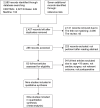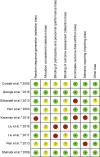Can dexmedetomidine reduce atrial fibrillation after cardiac surgery? A systematic review and meta-analysis
- PMID: 29559768
- PMCID: PMC5856293
- DOI: 10.2147/DDDT.S153834
Can dexmedetomidine reduce atrial fibrillation after cardiac surgery? A systematic review and meta-analysis
Abstract
Purpose: Cardiac surgery patients always present with atrial fibrillation (AF) after admission to the intensive care unit, leading to high mortality and lengthy hospitalization. Dexmedetomidine (DEX) is a popular medication used for sedation in the intensive care unit; however, whether it can reduce AF needs to be analyzed.
Materials and methods: Three primary databases, Medline, Embase (Ovid SP) and the Cochrane Central Register of Controlled Trials (CENTRAL), were searched. All English language and randomized control designed clinical publications comparing DEX to control medicines for sedation after elective cardiac surgery were included. Two independent colleagues conducted the data extraction and quality assessments. The subgroup analysis was performed according to the medicine used, age, AF history, and whether previous beta-blocker premedication and cardiopulmonary bypass (CPB) were applied. The overall incidence of AF was analyzed.
Results: A total of 1,295 patients in nine studies met the selection criteria among 2,587 studies screened from the database. After quantitative synthesis, our results revealed that the DEX group was not associated with a decreased incidence of AF compared with the placebo (risk ratio [RR] 0.76, 95% CI 0.37, 1.55, P=0.44) and morphine groups (RR 0.86, 95% CI 0.56, 1.31, P=0.48). Subgroup analysis also indicated that the DEX vs propofol comparison exhibited no difference: 1) for patients of age >60 years (P=0.69) or ≤60 years (P=0.69); 2) under CPB surgery (P=0.45) or without CPB surgery (P=0.88); 3) with beta-blocker premedication (P=0.32) or without beta-blocker premedication (P=0.90); and 4) with AF history (RR 1.07, 95% CI 0.85, 1.36, P=0.57) or without AF history (P=0.30).
Conclusion: This meta-analysis revealed that DEX could not reduce the incidence of AF compared to control medicines following cardiac surgery. DEX may have an increased influence on AF occurrence if patients had a history of AF. However, cautious interpretation should be made due to high clinical heterogeneity.
Keywords: atrial fibrillation; cardiac surgery; dexmedetomidine; sedation.
Conflict of interest statement
Disclosure The authors report no conflicts of interest in this work.
Figures
















Similar articles
-
Beta-blockers in patients without heart failure after myocardial infarction.Cochrane Database Syst Rev. 2021 Nov 5;11(11):CD012565. doi: 10.1002/14651858.CD012565.pub2. Cochrane Database Syst Rev. 2021. PMID: 34739733 Free PMC article.
-
Sertindole for schizophrenia.Cochrane Database Syst Rev. 2005 Jul 20;2005(3):CD001715. doi: 10.1002/14651858.CD001715.pub2. Cochrane Database Syst Rev. 2005. PMID: 16034864 Free PMC article.
-
Perioperative beta-blockers for preventing surgery-related mortality and morbidity.Cochrane Database Syst Rev. 2018 Mar 13;3(3):CD004476. doi: 10.1002/14651858.CD004476.pub3. Cochrane Database Syst Rev. 2018. PMID: 29533470 Free PMC article.
-
Chloral hydrate as a sedating agent for neurodiagnostic procedures in children.Cochrane Database Syst Rev. 2021 Aug 16;8(8):CD011786. doi: 10.1002/14651858.CD011786.pub3. Cochrane Database Syst Rev. 2021. PMID: 34397100 Free PMC article.
-
Intravenous versus inhalational maintenance of anaesthesia for postoperative cognitive outcomes in elderly people undergoing non-cardiac surgery.Cochrane Database Syst Rev. 2018 Aug 21;8(8):CD012317. doi: 10.1002/14651858.CD012317.pub2. Cochrane Database Syst Rev. 2018. PMID: 30129968 Free PMC article.
Cited by
-
Influence of Dexmedetomidine on Post-operative Atrial Fibrillation After Cardiac Surgery: A Meta-Analysis of Randomized Controlled Trials.Front Cardiovasc Med. 2021 Nov 25;8:721264. doi: 10.3389/fcvm.2021.721264. eCollection 2021. Front Cardiovasc Med. 2021. PMID: 34901203 Free PMC article.
-
Does Dexmedetomidine Reduce the Risk of Atrial Fibrillation and Stroke After Adult Cardiac Surgery? A Systematic Review and Meta-analysis of Randomized Controlled Trials.Anatol J Cardiol. 2022 May;26(5):354-365. doi: 10.5152/AnatolJCardiol.2022.1346. Anatol J Cardiol. 2022. PMID: 35552171 Free PMC article.
-
Association of Dexmedetomidine With New-Onset Atrial Fibrillation in Patients With Critical Illness.JAMA Netw Open. 2023 Apr 3;6(4):e239955. doi: 10.1001/jamanetworkopen.2023.9955. JAMA Netw Open. 2023. PMID: 37097632 Free PMC article.
-
Research status and advances in dexmedetomidine for sepsis‑induced multiple organ dysfunction syndrome (Review).Int J Mol Med. 2025 Jun;55(6):94. doi: 10.3892/ijmm.2025.5535. Epub 2025 Apr 17. Int J Mol Med. 2025. PMID: 40242975 Free PMC article. Review.
-
Effects of Dexmedetomidine on Basic Cardiac Electrophysiology in Adults; a Descriptive Review and a Prospective Case Study.Pharmaceuticals (Basel). 2022 Nov 8;15(11):1372. doi: 10.3390/ph15111372. Pharmaceuticals (Basel). 2022. PMID: 36355544 Free PMC article.
References
-
- Worden JC, Asare K. Postoperative atrial fibrillation: role of inflammatory biomarkers and use of colchicine for its prevention. Pharmacotherapy. 2014;34(11):1167–1173. - PubMed
-
- Ommen SR, Odell JA, Stanton MS. Atrial arrhythmias after cardiothoracic surgery. N Engl J Med. 1997;336(20):1429–1434. - PubMed
-
- Banach M, Kourliouros A, Reinhart KM, et al. Postoperative atrial fibrillation – What do we really know? Curr Vasc Pharmacol. 2010;8(4):553–572. - PubMed
-
- Karaman Y, Abud B, Tekgul ZT, Cakmak M, Yildiz M, Gonullu M. Effects of dexmedetomidine and propofol on sedation in patients after coronary artery bypass graft surgery in a fast-track recovery room setting. J Anesth. 2015;29(4):522–528. - PubMed
Publication types
MeSH terms
Substances
LinkOut - more resources
Full Text Sources
Other Literature Sources
Medical
Miscellaneous

